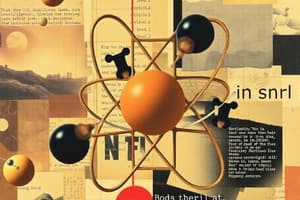Podcast
Questions and Answers
Quelle est la particule chargée positivement située au centre de l'atome ?
Quelle est la particule chargée positivement située au centre de l'atome ?
- Le noyau
- Le proton (correct)
- Le neutron
- L'électron
Quel élément détermine l'identité d'un atome sur le tableau périodique ?
Quel élément détermine l'identité d'un atome sur le tableau périodique ?
- Le nombre de neutrons
- Le nombre d'électrons
- La somme des protons et des neutrons
- Le nombre de protons (correct)
Quelle particule n'a pas de charge électrique ?
Quelle particule n'a pas de charge électrique ?
- Toutes les particules ont une charge
- Le proton
- L'électron
- Le neutron (correct)
Où se trouvent les électrons dans un atome ?
Où se trouvent les électrons dans un atome ?
Quelle particule détermine la masse atomique d'un élément ?
Quelle particule détermine la masse atomique d'un élément ?
Comment les isotopes d'un même élément diffèrent-ils ?
Comment les isotopes d'un même élément diffèrent-ils ?
Quelle est la principale raison pour laquelle les électrons déterminent les propriétés chimiques des éléments ?
Quelle est la principale raison pour laquelle les électrons déterminent les propriétés chimiques des éléments ?
Quel est le nombre maximal d'électrons que les deux premières couches électroniques peuvent contenir ?
Quel est le nombre maximal d'électrons que les deux premières couches électroniques peuvent contenir ?
Qu'est-ce qui détermine la forme générale d'un atome ?
Qu'est-ce qui détermine la forme générale d'un atome ?
Que représente la masse atomique d'un élément ?
Que représente la masse atomique d'un élément ?
Que sont les isotopes ?
Que sont les isotopes ?
Comment calcule-t-on la masse atomique d'un élément ?
Comment calcule-t-on la masse atomique d'un élément ?
Flashcards are hidden until you start studying
Study Notes
Atoms: Understanding Their Structure and Composition
Atoms, the fundamental units of matter, have been studied extensively over several centuries. They consist of three main parts: protons, neutrons, and electrons. These particles interact with each other through various forces and are responsible for the properties of different elements. Let's delve deeper into the components of atoms and their structural organization.
Protons, Neutrons, and Electrons
Protons
Protons were discovered by Ernest Rutherford in 1919, and they carry the electric charge equal to one unit of positive charge. They are located at the center of an atom, known as the nucleus. Each element has a specific number of protons in its nucleus, which determines its identity on the periodic table.
Neutrons
Neutrons, discovered by James Chadwick in 1932, have no net electric charge and are approximately neutral. Like protons, they reside within the nucleus of an atom. However, unlike protons, neutrons are not unique to any particular element. For example, carbon-14 isotope contains 6 protons and 8 neutrons, whereas carbon-12 has 6 protons and 6 neutrons.
Electrons
Electrons are negatively charged subatomic particles that orbit around the nucleus of an atom in discrete energy levels called shells. Each electron has a specific energy level in an atom, determined by the number of protons in the nucleus of the atom. Electrons also determine the chemical properties of elements because they participate in chemical reactions.
Atomic Structure and Organization
The arrangement of protons, neutrons, and electrons within an atom is essential to understanding its properties. The overall shape of an atom depends on the distribution of electrons in different shells. There are seven different types of electron configurations possible, depending on the number of electrons in an atom.
The first two shells can hold up to eight electrons, while subsequent shells can hold more. This means that many elements have multiple electron configurations, depending on how many electrons are present in the outermost shell. In general, the electron configurations tend to follow certain patterns based on the filling order of the shells.
Atomic Mass and Isotopes
Atomic mass, often denoted as m or A, represents the average mass of all naturally occurring isotopes of a given element. It takes into account both the proton-neutron count and the relative abundance of these isotopes in nature. Isotopes, molecules or nuclides containing the same number of protons but a varying number of neutrons, contribute differently to the total atomic mass.
For example, Carbon has six stable isotopes, each with a slightly different atomic mass due to differences in the neutron count. To calculate an element's atomic mass, it is necessary to consider the contribution from each isotope based on its natural abundance.
In summary, understanding the structure and composition of atoms involves studying their fundamental components - protons, neutrons, and electrons - and understanding how these particles arrange themselves within the atom. This knowledge is crucial for explaining the properties of elements in the physical world we live in.
Studying That Suits You
Use AI to generate personalized quizzes and flashcards to suit your learning preferences.




